NEETS Module 5 - Introduction to Generators and Motors
Pages i,
1-1,
1-11,
1-21,
1-31,
2-1,
2-11,
3-1,
3-11,
4-1,
4-11, Index
turn. To obtain maximum
interaction between the fields, the air gap between the rotor and stator is very small. As you know from
Lenz's law, any induced EMF tries to oppose the changing field that induces it. In the case of an induction motor,
the changing field is the motion of the resultant stator field. a force is exerted on the rotor by the induced EMF
and the resultant magnetic field. This force tends to cancel the relative motion between the rotor and the stator
field. The rotor, as a result, moves in the same direction as the rotating stator field. It is impossible
for the rotor of an induction motor to turn at the same speed as the rotating magnetic field. If the speeds were
the same, there would be no relative motion between the stator and rotor fields; without relative motion there
would be no induced voltage in the rotor. In order for relative motion to exist between the two, the rotor must
rotate at a speed slower than that of the rotating magnetic field. The. difference between the speed of the
rotating stator field and the rotor speed is called slip. The smaller the slip, the closer the rotor speed
approaches the stator field speed.
The speed of the rotor depends upon the torque requirements of the load. The bigger the load, the stronger the
turning force needed to rotate the rotor. The turning force can increase only if the rotor- induced EMF increases.
This EMF can increase only if the magnetic field cuts through the rotor at a faster rate. To increase the relative
speed between the field and rotor, the rotor must slow down. Therefore, for heavier loads the induction motor
turns slower than for lighter loads. You can see from the previous statement that slip is directly proportional to
the load on the motor. Actually only a slight change in speed is necessary to produce the usual current changes
required for normal changes in load. This is because the rotor windings have such a low resistance. As a result,
induction motors are called constant-speed motors. Q8. Why is the ac induction motor used more often
than other types?
Q9. The speed of the rotor is always somewhat less than the speed of the rotating field. What is the difference
called? Q10. What determines the amount of slip in an induction motor? Single-Phase INDUCTION MOTORS There are probably more single-phase ac induction
motors in use today than the total of all the other types put together. It is logical that the least
expensive, lowest maintenance type of ac motor should be used most often. The single-phase ac induction motor fits
that description. Unlike polyphase induction motors, the stator field in the single-phase motor does not
rotate. Instead it simply alternates polarity between poles as the ac voltage changes polarity. Voltage is
induced in the rotor as a result of magnetic induction, and a magnetic field is produced around the rotor. This
field will always be in opposition to the stator field (Lenz's law applies). The interaction between the rotor and
stator fields will not produce rotation, however. The interaction is shown by the double-ended arrow in figure
4-10, view A. Because this force is across the rotor and through the pole pieces, there is no rotary motion, just
a push and/or pull along this line.
4-11
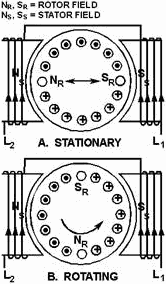
Figure 4-10. - Rotor currents in a single-phase ac induction motor. Now, if the rotor is rotated by some outside force (a twist of your hand, or something), the push-pull
along the line in figure 4-10, view A, is disturbed. Look at the fields as shown in figure 4-10, view B. At this
instant the south pole on the rotor is being attracted by the left-hand pole. The north rotor pole is being
attracted to the right-hand pole. All of this is a result of the rotor being rotated 90º by the outside force.
The pull that now exists between the two fields becomes a rotary force, turning the rotor toward magnetic
correspondence with the stator. Because the two fields continuously alternate, they will never actually line up,
and the rotor will continue to turn once started. It remains for us to learn practical methods of getting the
rotor to start. There are several types of single-phase induction motors in use today. Basically they are
identical except for the means of starting. In this chapter we will discuss the split-phase and shaded-pole
motors; so named because of the methods employed to get them started. Once they are up to operating speed, all
single-phase induction motors operate the same.
Q11. What type of ac motor is most widely used? Split-Phase Induction Motors
One type of induction motor, which incorporates a starting device, is called a split-phase induction motor.
Split-phase motors are designed to use inductance, capacitance, or resistance to develop a starting torque. The
principles are those that you learned in your study of alternating current. Capacitor-START. - The
first type of split-phase induction motor that will be covered is the capacitor-start type. Figure 4-11 shows a
simplified schematic of a typical capacitor-start motor. The stator consists of the main winding and a starting
winding (auxiliary). The starting winding is connected in parallel with the main winding and is placed physically
at right angles to it. a 90-degree electrical
4-12
phase difference between the two windings is obtained by connecting the auxiliary winding in series
with a capacitor and starting switch. When the motor is first energized, the starting switch is closed. This
places the capacitor in series with the auxiliary winding. The capacitor is of such value that the auxiliary
circuit is effectively a resistive-capacitive circuit (referred to as capacitive reactance and expressed as XC).
In this circuit the current leads the line voltage by about 45º (because XC about equals R). The main
winding has enough resistance-inductance (referred to as inductive reactance and expressed as XL) to
cause the current to lag the line voltage by about 45º (because XL about equals R). The currents in
each winding are therefore 90º out of phase - so are the magnetic fields that are generated. The effect is that
the two windings act like a two-phase stator and produce the rotating field required to start the motor.
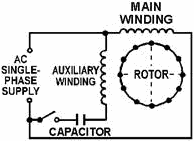
Figure 4-11. - Capacitor-start, ac induction motor. When nearly full speed is obtained, a centrifugal device (the starting switch) cuts out the starting
winding. The motor then runs as a plain single-phase induction motor. Since the auxiliary winding is only a light
winding, the motor does not develop sufficient torque to start heavy loads. Split-phase motors, therefore, come
only in small sizes.
Resistance-START. - Another type of split-phase induction motor is the resistance-start
motor. This motor also has a starting winding (shown in fig. 4-12) in addition to the main winding. It is switched
in and out of the circuit just as it was in the capacitor-start motor. The starting winding is positioned at right
angles to the main winding. The electrical phase shift between the currents in the two windings is obtained by
making the impedance of the windings unequal. The main winding has a high inductance and a low resistance. The
current, therefore, lags the voltage by a large angle. The starting winding is designed to have a fairly low
inductance and a high resistance. Here the current lags the voltage by a smaller angle. For example, suppose the
current in the main winding lags the voltage by 70º. The current in the auxiliary winding lags the voltage by
40º. The currents are, therefore, out of phase by 30º. The magnetic fields are out of phase by the same amount.
Although the ideal angular phase difference is 90º for maximum starting torque, the 30-degree phase difference
still generates a rotating field. This supplies enough torque to start the motor. When the motor comes up to
speed, a speed-controlled switch disconnects the starting winding from the line, and the motor continues to run as
an induction motor. The starting torque is not as great as it is in the capacitor-start.
4-13
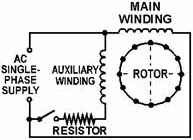
Figure 4-12. - Resistance-start ac induction motor. Q12. How do split-phase induction motors become self-starting?
Shaded-Pole Induction Motors The shaded-pole induction motor is another single-phase
motor. It uses a unique method to start the rotor turning. The effect of a moving magnetic field is produced by
constructing the stator in a special way. This motor has projecting pole pieces just like some dc motors. In
addition, portions of the pole piece surfaces are surrounded by a copper strap called a shading coil. a pole piece
with the strap in place is shown in figure 4-13. The strap causes the field to move back and forth across the face
of the pole piece. Note the numbered sequence and points on the magnetization curve in the figure. As the
alternating stator field starts increasing from zero (1), the lines of force expand across the face of the pole
piece and cut through the strap. a voltage is induced in the strap. The current that results generates a field
that opposes the cutting action (and decreases the strength) of the main field. This produces the following
actions: As the field increases from zero to a maximum at 90º , a large portion of the magnetic lines of force are
concentrated in the unshaded portion of the pole (1). At 90º the field reaches its maximum value. Since the lines
of force have stopped expanding, no EMF is induced in the strap, and no opposing magnetic field is generated. As a
result, the main field is uniformly distributed across the pole (2). From 90º to 180º , the main field starts
decreasing or collapsing inward. The field generated in the strap opposes the collapsing field. The effect is to
concentrate the lines of force in the shaded portion of the pole face (3). You can see that from 0º to 180º , the
main field has shifted across the pole face from the unshaded to the shaded portion. From 180º to 360º , the main
field goes through the same change as it did from 0º to 180º ; however, it is now in the opposite direction (4).
The direction of the field does not affect the way the shaded pole works. The motion of the field is the same
during the second half-cycle as it was during the first half of the cycle.
4-14
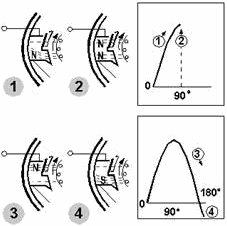
Figure 4-13. - Shaded poles as used in shaded-pole ac induction motors. The motion of the field back and forth between shaded and unshaded portions produces a weak torque to
start the motor. Because of the weak starting torque, shaded-pole motors are built only in small sizes. They drive
such devices as fans, clocks, blowers, and electric razors. Q13. Why are shaded-pole motors used to
drive only very small devices? Speed of Single-Phase Induction Motors
The speed of induction motors is dependent on motor design. The synchronous speed (the speed at which the stator
field rotates) is determined by the frequency of the input ac power and the number of poles in the stator. The
greater the number of poles, the slower the synchronous speed. The higher the frequency of applied voltage, the
higher the synchronous speed. Remember, however, that neither frequency nor number of poles are variables. They
are both fixed by the manufacturer.
The relationship between poles, frequency, and synchronous speed is as follows:

where n is the synchronous speed in rpm, f is the frequency of applied voltage in hertz, and p is the
number of poles in the stator. Let's use an example of a 4-pole motor, built to operate on 60 hertz. The
synchronous speed is determined as follows:
4-15

Common synchronous speeds for 60-hertz motors are 3600, 1800, 1200, and 900 rpm, depending on the number
of poles in the original design. As we have seen before, the rotor is never able to reach synchronous
speed. If it did, there would be no voltage induced in the rotor. No torque would be developed. The motor would
not operate. The difference between rotor speed and synchronous speed is called slip. The difference between these
two speeds is not great. For example, a rotor speed of 3400 to 3500 rpm can be expected from a synchronous speed
of 3600 rpm.
Summary This chapter introduced you to the basic principles concerning ac motors. While many variations of types
exist, the three types presented provide you with background for further study if you require more extensive
knowledge of the subject. The following information provides a summary of the major subjects of this chapter for
your review. The three AC MOTOR TYPES presented are the series, synchronous, and
induction ac motors. AC Series MOTORS are nearly identical to the dc series motors.
Special construction techniques allow ac series motors to be used as UNIVERSAL MOTORS, operating
on either ac or dc power.
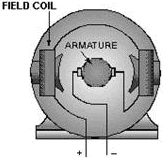
ROTATING FIELDS are developed by applying multiphase voltages to stator windings, which
consist of multiple field coils. This rotating magnetic field causes the rotor to be pushed and pulled because of
interaction between it and the rotor's own field. TWO-Phase ROTATING FIELDS require two
pairs of field coils displaced by 90º. They must be energized by voltages that also have a phase displacement of
90º.
4-16
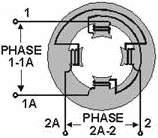
THREE-Phase ROTATING FIELDS require three pairs of windings 120º apart, energized by
voltages that also have a 120-degree phase displacement.

SYNCHRONOUS MOTORS are specifically designed to maintain constant speed, with the rotor
synchronous to the rotating field. Synchronous motors require modification (such as squirrel-cage windings) to be
self-starting.
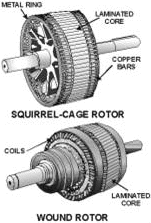
4-17
INDUCTION MOTORS are the most commonly used of all electric motors due to their
simplicity and low cost. Induction motors may be single-phase or multiphase. They do not require electrical rotor
connection. Split-phase motors with special starting windings, and shaded-pole motors, are types of single-phase
induction motors.
SYNCHRONOUS SPEED is the speed of stator field rotation. It is determined by the number of poles
and the frequency of the input voltage. Thus, for a given motor, synchronous speed is constant.
SLIP is the difference between actual rotor speed and the synchronous speed in induction motors.
Slip must exist for there to be torque at the rotor shaft.
Answers to Questions Q1. Through Q13. A1. Series, synchronous, induction. A2. To power small appliances. A3. They
operate on either ac or dc. A4. The number of phases in the applied voltage. A5. 90º.
A6. Number and location of field poles. A7. Constant speed required by some loads.
A8. They are simple and inexpensive to make. A9. Slip. A10. Load. A11.
Single-phase induction motor.
A12. By using combinations of inductance and capacitance to apply out-of phase currents in starting windings.
A13. They have very weak starting torques.
4-18
| - |
Matter, Energy,
and Direct Current |
| - |
Alternating Current and Transformers |
| - |
Circuit Protection, Control, and Measurement |
| - |
Electrical Conductors, Wiring Techniques,
and Schematic Reading |
| - |
Generators and Motors |
| - |
Electronic Emission, Tubes, and Power Supplies |
| - |
Solid-State Devices and Power Supplies |
| - |
Amplifiers |
| - |
Wave-Generation and Wave-Shaping Circuits |
| - |
Wave Propagation, Transmission Lines, and
Antennas |
| - |
Microwave Principles |
| - |
Modulation Principles |
| - |
Introduction to Number Systems and Logic Circuits |
| - |
- Introduction to Microelectronics |
| - |
Principles of Synchros, Servos, and Gyros |
| - |
Introduction to Test Equipment |
| - |
Radio-Frequency Communications Principles |
| - |
Radar Principles |
| - |
The Technician's Handbook, Master Glossary |
| - |
Test Methods and Practices |
| - |
Introduction to Digital Computers |
| - |
Magnetic Recording |
| - |
Introduction to Fiber Optics |
| Note: Navy Electricity and Electronics Training
Series (NEETS) content is U.S. Navy property in the public domain. |
|

















